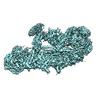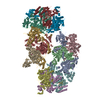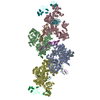[English] 日本語
 Yorodumi
Yorodumi- EMDB-4169: N terminal region of dynein tail domains in complex with dynactin... -
+ Open data
Open data
- Basic information
Basic information
| Entry | Database: EMDB / ID: EMD-4169 | |||||||||
|---|---|---|---|---|---|---|---|---|---|---|
| Title | N terminal region of dynein tail domains in complex with dynactin filament and BICDR-1 | |||||||||
 Map data Map data | Map of the N-terminal half of two dynein tail domains bound to dynactin and BICDR1. This map was generated after particle signal subtraction from the overall map (separate deposition) | |||||||||
 Sample Sample |
| |||||||||
| Function / homology |  Function and homology information Function and homology informationRHOD GTPase cycle / Factors involved in megakaryocyte development and platelet production / Golgi to secretory granule transport / RHOF GTPase cycle / dynactin complex / Regulation of PLK1 Activity at G2/M Transition / Loss of Nlp from mitotic centrosomes / Recruitment of mitotic centrosome proteins and complexes / Loss of proteins required for interphase microtubule organization from the centrosome / Anchoring of the basal body to the plasma membrane ...RHOD GTPase cycle / Factors involved in megakaryocyte development and platelet production / Golgi to secretory granule transport / RHOF GTPase cycle / dynactin complex / Regulation of PLK1 Activity at G2/M Transition / Loss of Nlp from mitotic centrosomes / Recruitment of mitotic centrosome proteins and complexes / Loss of proteins required for interphase microtubule organization from the centrosome / Anchoring of the basal body to the plasma membrane / AURKA Activation by TPX2 / transport along microtubule / WASH complex / F-actin capping protein complex / positive regulation of intracellular transport / dynein light chain binding / negative regulation of filopodium assembly / regulation of metaphase plate congression / dynein heavy chain binding / establishment of spindle localization / axonemal dynein complex / positive regulation of spindle assembly / vesicle transport along microtubule / dynein complex / COPI-independent Golgi-to-ER retrograde traffic / P-body assembly / minus-end-directed microtubule motor activity / barbed-end actin filament capping / dynein light intermediate chain binding / cytoplasmic dynein complex / regulation of cell morphogenesis / retrograde axonal transport / regulation of lamellipodium assembly / nuclear migration / Recruitment of NuMA to mitotic centrosomes / HSP90 chaperone cycle for steroid hormone receptors (SHR) in the presence of ligand / MHC class II antigen presentation / COPI-mediated anterograde transport / microtubule motor activity / dynein intermediate chain binding / microtubule-based movement / cytoplasmic microtubule / dynactin binding / Amplification of signal from unattached kinetochores via a MAD2 inhibitory signal / COPI-mediated anterograde transport / stress granule assembly / Mitotic Prometaphase / cytoplasmic microtubule organization / EML4 and NUDC in mitotic spindle formation / regulation of mitotic spindle organization / Loss of Nlp from mitotic centrosomes / Loss of proteins required for interphase microtubule organization from the centrosome / axon cytoplasm / Recruitment of mitotic centrosome proteins and complexes / cytoskeleton organization / Recruitment of NuMA to mitotic centrosomes / Resolution of Sister Chromatid Cohesion / Anchoring of the basal body to the plasma membrane / HSP90 chaperone cycle for steroid hormone receptors (SHR) in the presence of ligand / MHC class II antigen presentation / sarcomere / AURKA Activation by TPX2 / mitotic spindle organization / filopodium / RHO GTPases Activate Formins / cell morphogenesis / small GTPase binding / Aggrephagy / HCMV Early Events / Separation of Sister Chromatids / neuron projection development / Regulation of PLK1 Activity at G2/M Transition / azurophil granule lumen / actin filament binding / positive regulation of cold-induced thermogenesis / actin binding / cell cortex / actin cytoskeleton organization / microtubule / vesicle / cell division / centrosome / Neutrophil degranulation / ATP hydrolysis activity / RNA binding / extracellular exosome / extracellular region / ATP binding / membrane / cytoplasm / cytosol Similarity search - Function | |||||||||
| Biological species |   Homo sapiens (human) / Homo sapiens (human) /   | |||||||||
| Method | single particle reconstruction / cryo EM / Resolution: 3.4 Å | |||||||||
 Authors Authors | Urnavicius L / Lau CK / Elshenawy MM / Morales-Rios E / Motz C / Yildiz A / Carter AP | |||||||||
| Funding support |  United Kingdom, 2 items United Kingdom, 2 items
| |||||||||
 Citation Citation |  Journal: Nature / Year: 2018 Journal: Nature / Year: 2018Title: Cryo-EM shows how dynactin recruits two dyneins for faster movement. Authors: Linas Urnavicius / Clinton K Lau / Mohamed M Elshenawy / Edgar Morales-Rios / Carina Motz / Ahmet Yildiz / Andrew P Carter /    Abstract: Dynein and its cofactor dynactin form a highly processive microtubule motor in the presence of an activating adaptor, such as BICD2. Different adaptors link dynein and dynactin to distinct cargoes. ...Dynein and its cofactor dynactin form a highly processive microtubule motor in the presence of an activating adaptor, such as BICD2. Different adaptors link dynein and dynactin to distinct cargoes. Here we use electron microscopy and single-molecule studies to show that adaptors can recruit a second dynein to dynactin. Whereas BICD2 is biased towards recruiting a single dynein, the adaptors BICDR1 and HOOK3 predominantly recruit two dyneins. We find that the shift towards a double dynein complex increases both the force and speed of the microtubule motor. Our 3.5 Å resolution cryo-electron microscopy reconstruction of a dynein tail-dynactin-BICDR1 complex reveals how dynactin can act as a scaffold to coordinate two dyneins side-by-side. Our work provides a structural basis for understanding how diverse adaptors recruit different numbers of dyneins and regulate the motile properties of the dynein-dynactin transport machine. | |||||||||
| History |
|
- Structure visualization
Structure visualization
| Movie |
 Movie viewer Movie viewer |
|---|---|
| Structure viewer | EM map:  SurfView SurfView Molmil Molmil Jmol/JSmol Jmol/JSmol |
| Supplemental images |
- Downloads & links
Downloads & links
-EMDB archive
| Map data |  emd_4169.map.gz emd_4169.map.gz | 288.4 MB |  EMDB map data format EMDB map data format | |
|---|---|---|---|---|
| Header (meta data) |  emd-4169-v30.xml emd-4169-v30.xml emd-4169.xml emd-4169.xml | 27.6 KB 27.6 KB | Display Display |  EMDB header EMDB header |
| Images |  emd_4169.png emd_4169.png | 139 KB | ||
| Others |  emd_4169_additional_1.map.gz emd_4169_additional_1.map.gz emd_4169_additional_2.map.gz emd_4169_additional_2.map.gz | 1 MB 1.2 MB | ||
| Archive directory |  http://ftp.pdbj.org/pub/emdb/structures/EMD-4169 http://ftp.pdbj.org/pub/emdb/structures/EMD-4169 ftp://ftp.pdbj.org/pub/emdb/structures/EMD-4169 ftp://ftp.pdbj.org/pub/emdb/structures/EMD-4169 | HTTPS FTP |
-Validation report
| Summary document |  emd_4169_validation.pdf.gz emd_4169_validation.pdf.gz | 226.6 KB | Display |  EMDB validaton report EMDB validaton report |
|---|---|---|---|---|
| Full document |  emd_4169_full_validation.pdf.gz emd_4169_full_validation.pdf.gz | 225.7 KB | Display | |
| Data in XML |  emd_4169_validation.xml.gz emd_4169_validation.xml.gz | 8.3 KB | Display | |
| Arichive directory |  https://ftp.pdbj.org/pub/emdb/validation_reports/EMD-4169 https://ftp.pdbj.org/pub/emdb/validation_reports/EMD-4169 ftp://ftp.pdbj.org/pub/emdb/validation_reports/EMD-4169 ftp://ftp.pdbj.org/pub/emdb/validation_reports/EMD-4169 | HTTPS FTP |
-Related structure data
| Related structure data |  6f1uMC  4168C  4170C  4171C  4172C  4177C  5owoC  6f1tC  6f1vC  6f1yC  6f1zC  6f38C  6f3aC C: citing same article ( M: atomic model generated by this map |
|---|---|
| Similar structure data |
- Links
Links
| EMDB pages |  EMDB (EBI/PDBe) / EMDB (EBI/PDBe) /  EMDataResource EMDataResource |
|---|---|
| Related items in Molecule of the Month |
 Movie
Movie Controller
Controller Sample components
Sample components


 UCSF Chimera
UCSF Chimera






